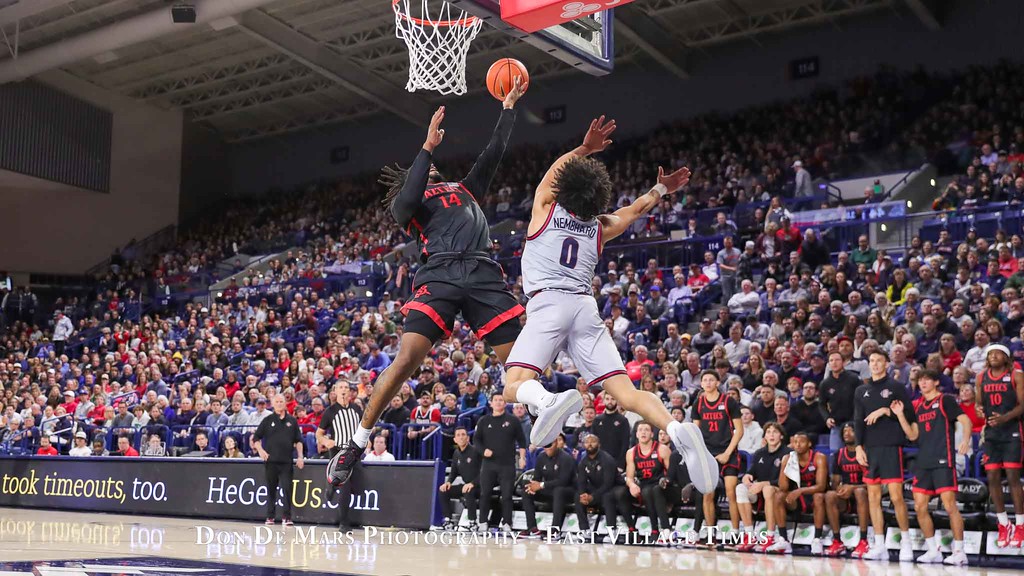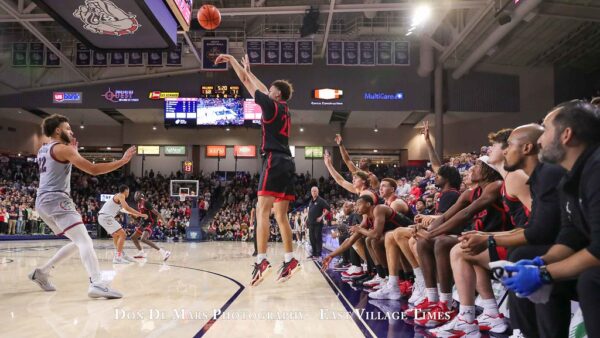Analyzing SDSU’s win over Gonzaga

Credit: Don De Mars/ EVT Sports

The Aztecs traveled to Spokane and beat Gonzaga in their arena 84-74. It is the kind of victory that shows the high potential of this SDSU team. Only one other team in 73 tries against the Bulldogs accomplished what the Aztecs did on Friday. Below is a look at how the Aztecs accomplished the goals laid out in the preview of the game.
Transition play
The first key to defending Gonzaga well in the article previewing the contest was preventing transition play. Heading into the game, Gonzaga averaged 20.8 points per game in transition on 19.5 plays per game. According to Synergy Sports, the Aztecs held Gonzaga to 11 points on 11 attempts. They were successful in limiting the attempts, as well as keeping the points per possession slightly lower.
One of the highlights was the steal by Reese Waters, pictured below. Jaedon LeDee had a slow first step getting back in transition. Graham Ike recognized it and took off. It would’ve been an easy two points if not for Waters’ recognition of the situation. Instead, he was able to make a play, and the Aztecs were rewarded with a big run to start the second half.
Reese Waters prevents an easy 2 points. pic.twitter.com/lMVkepYsKt
— Aztec Breakdown (@aztecbreakdown) December 31, 2023
Defensive rebounding
The other main key was preventing offensive rebounds. The Bulldogs were averaging almost fourteen per game and had been very efficient with them. During Friday’s contest, the Gonzaga bigs continued to use the tricks that were highlighted in the preview to position their guys for offensive rebounds. In the clip below, Ike has great position after LeDee leaves to contest Andrew Nembhard’s shot. There’s no one to box him out, and he gets an easy putback.
Ike gets the offensive rebound for the score. pic.twitter.com/uF8JtefmqO
— Aztec Breakdown (@aztecbreakdown) December 31, 2023
Despite that, the Aztecs held them to only eleven offensive rebounds and roughly seven percentage points below their average. Gonzaga was very efficient on the putback chances they got, averaging 1.375 points per attempt on those plays according to synergy sports, so limiting the attempts was key.
Post play/defending Graham Ike
The Aztecs double-teamed Ike a lot in the post. They didn’t send the double team right away, though, usually opting to wait until Ike dribbled the ball. There is an example of that in the above clip. Ike is a great player, so he still has his numbers, but the turnover below is a result of that later double team.
The benefit of waiting until the dribble is the offensive player has fewer options to escape and has to make reads faster or give up the dribble. Ike does a good job of recognizing the open man, but Waters does at the same time and jumps the passing lane, resulting in a score on the other end. It was great timing by everyone involved.
Waters with the steal out of the Ike double team. pic.twitter.com/e5ZlrjWMgQ
— Aztec Breakdown (@aztecbreakdown) December 31, 2023
Switching screens on defense
One thing Gonzaga was able to take advantage of most of the night was when the Aztecs switched on screens. It usually left a small player defending a big player, and Gonzaga punished the Aztecs inside because of it. SDSU attempted to remedy the situation in two ways.
One was to switch off ball when possible. The other was to do a double switch in the moment of the screen. The clip below shows a failed double switch. The Aztecs successfully built a wall on defense to prevent the transition attempt, and Gonzaga flows into a Chicago action. When the switch happened, Reese Waters was half a step slow in realizing he needed to cover Anton Watson, which left Darrion Trammell to cover longer than he should’ve. That left Nolan Hickman open on the wing, and he successfully hit a three-point shot.
Aztecs blew the double switch, leading to an open 3. pic.twitter.com/pOaDsns3SV
— Aztec Breakdown (@aztecbreakdown) December 31, 2023
Attacking the hedge defense
The primary defense highlighted in the preview was a hedging defense. Gonzaga did a lot of that to start the game. The clip below shows a play that was run a few times with success against the hedge.
This Cross Ram action worked against a hedge defense because the defensive big man couldn’t help on the second screen set by Miles Heide, as he has a long way to recover. Butler made it especially hard by being aggressive and forcing the big man to cover him for longer. The lack of help meant the Gonzaga big couldn’t hedge the second screen and prevent Darrion Trammell from getting the shot off.
This Cross Ram action worked well against the hedge. pic.twitter.com/816NeO9417
— Aztec Breakdown (@aztecbreakdown) December 31, 2023
The Aztecs ran this play multiple times with success. In the second half, Waters got a basket off the same action. He decided to drive first rather than take the immediate shot, and that let Ike get back into position, but Nolan Hickman never fully recovered, and Waters was able to get the separation he needed.
Cross Ram action version 2. pic.twitter.com/7DeTJGdsu4
— Aztec Breakdown (@aztecbreakdown) December 31, 2023
In the preview, one clip showed a UCONN big man drawing multiple defenders due to his role gravity and how that play could help SDSU. This isn’t that play, but it works on the same principle.
Gonzaga was switching on defense here but didn’t want a guard defending LeDee, so they had to double-switch. Braden Huff didn’t recognize it and was late, forcing Anton Watson to stay in the paint longer than he should. The delay gave Miles Byrd a wide open 3 pointer in the corner.
Crucial shot by Byrd. Gonzaga blew their coverage and didn’t know where to switch. pic.twitter.com/YOgbOQYQ5G
— Aztec Breakdown (@aztecbreakdown) December 31, 2023
Beating the press
The big question of the game was the press break. Gonzaga ran a 1-2-2 press that the Aztecs hadn’t seen yet this season. SDSU handled the press well in the first half, showing they know what they’re supposed to do. A coach could use the clip below to show the proper way to break this style of press.
Aztecs successfully beat the press in the first half. pic.twitter.com/HRUJqJSk1a
— Aztec Breakdown (@aztecbreakdown) December 31, 2023
The key thing to know about the 1-2-2 is that it’s goal is to trap the ball carrier right after they cross the half court line. The simple way to beat it is to dribble up to the line without crossing it and then pass the ball over the line, ideally not in the corner.
In the second half, the big difference was the intensity Gonzaga brought to their press. In the clip below, Nembhard rushed Elijah Saunders faster than in the first clip, throwing off the timing for the next pass, so Saunders had to pass back to the safety valve. Then, Butler decided to dribble the ball over and try to turn the corner on Hickman. It was an aggressive play, but Hickman cut Butler off, and the Bulldogs got the trap exactly where they wanted it.
Gonzaga turns up the heat on the press, and SDSU makes a crucial mistake of dribbling over the line. pic.twitter.com/3F7Nga4ZXd
— Aztec Breakdown (@aztecbreakdown) December 31, 2023
On the next play, Saunders, for some reason, didn’t try to get the defense to shift by pushing the ball. He simply passed the ball back to Butler, who then tried to split the double team. It’s another play that would’ve been amazing if it had worked, but it isn’t going to work often. It wasn’t a good decision by either Butler or Saunders, and it was the last play of the game for Butler.
Butler tries to split the double team but can’t make it through. pic.twitter.com/ngy3dZVFai
— Aztec Breakdown (@aztecbreakdown) December 31, 2023
In the next play, Gonzaga had a little tweak that very well may have been unintentional. They ended up not pressing as hard, but Saunders picked the ball up early. That allowed Gonzaga to play ball denial rather than commit two defenders to stop the ball. The first look was still the opposite side of the floor, but that wasn’t open partly due to LeDee’s lackadaisical cut. In that situation, it’s imperative that the player on the opposite side of the floor cuts looking for the pass.
Saunders doesn’t quite draw two when he picks up the dribble, and players around him don’t cut well, leading to another turnover. pic.twitter.com/gLNnq6bdIW
— Aztec Breakdown (@aztecbreakdown) December 31, 2023
Over the course of the game, Gonzaga tried a press defense 10 times. SDSU beat it six out of those ten times.
Overall, the Aztecs did a good job of identifying the things that needed to be done and executing them. They limited transition opportunities, which arguably had the largest impact on the game. They held Gonzaga to below their season average for offensive rebounds. The Aztecs were ready to attack the hedge defense, and they adjusted well when Gonzaga started to switch on defense rather than hedge.
Ike still got his numbers, so they may need to find a new strategy for other dominant post players. The press defense also posed problems. A deeper team will be able to take advantage of that for longer if the Aztecs don’t fix it. They did enough to get the win, however, and as a result, SDSU has set itself up nicely for an at-large bid to the NCAA tournament. If they continue to improve and execute their game plans, another run may be in store.
Native San Diegan living in Montana. Big time Aztec Basketball fan. Creator of Aztec Breakdown. Hoping to help people enjoy basketball more by increasing their understanding of it.